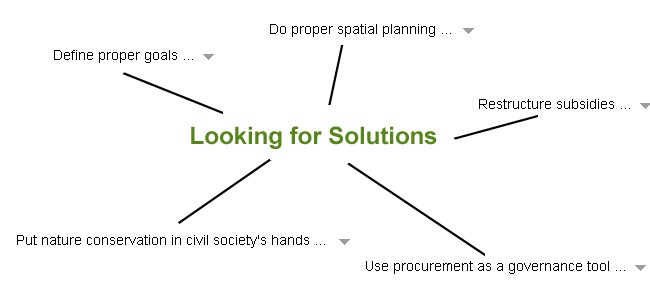
Do proper spatial planning
“One of the approaches that we're looking at in Wales is spatial planning, because to create a spatial plan you have to bring all the actors around the table. You have to have private sector developers, you have to have local authorities, you have to have civil society groups and you have to have central government and its agencies to agree how environmental resources are used and how they are conserved. And it seems to me this provides some real opportunity. It is slow getting off the ground because there are some very entrenched views about how the territories of Wales, the terrestrial and the marine, are considered in law.” (Morgan Parry)
“I have come to know planners in say the last 9 years pretty much for the first time. And firstly in this country at least they have no economic training generally, they are trained to plan and that is about it. They then enter into a very rigid career structure. If they are in local authorities and helping make decisions which have become only centralized by government intervention etc. There is a cascade of national and regional policies which really limits their scope for creativity. The last point I would make is that they are told usually to take their hands off economics. So if a developer comes forward saying I want to put a factory there or I want to put a new housing estate there, the economics of it are sometimes purposely disregarded because that is a matter for the applicant. If they can afford it, if it is profitable, it is not a matter for planners to concern themselves with. So I think it will be a long struggle to make planners, as we're turning them out in this country, understand and react to more refined ways of introducing economics into planning. I am sorry for being pessimistic.” (Andy Tickle)
“Planning (…) is necessarily a top down procedure. Civil society is basically a bottom up procedure so here we have an area of conflict. There is no way you can streamline those two. So the issue is: how do you organize that conflict? I mean if the conflict is inbuilt, you can't prevent it, you have to deal with it. You can’t stop it, you have to organize a way of solving it in each and every case. (…) What we need is a formalized system to make democratic and bottom up movements come together with top-down planning procedures.” (Rupert Graf Strachwitz)
“Yes, and I think planning is not a one-man business in which one has ideas and decides how it is done. Planning is a dialogue and we have some examples: We have the Leader process in the EU, we have the Local-agenda process. This is a kind of bottom-up process and you don't get support from the state here without mediation, without dialogue with the inhabitants. And in nature protection especially – where you deal with big areas – you always have to be in touch and in discussion with the people that live around there and this is very formula like, because sometimes the support by the state is cut after one or two years when the dialogue has fizzled out.” (Holger Belz)
Restructure subsidies
“I think typically in the field of land management, perverse subsidies have been one of the main reasons why biodiversity has been lost. And I think the engagement with farmers now is about showing how public subsidies through European agricultural support schemes can actually be turned to provide other public goods. Take the case of food, which already has a price in the market place. Food is traded and it has a price but many of the other things that we are trying to secure as ecosystem services don't yet have a price in the market. So biodiversity, or water quality, or ecosystem function at any level doesn't have a price yet in the market. So the government through its intervention has to create markets which produce incomes which in turn keep people working in the countryside. In my conversations with farmers, their main concern is to keep active communities living and working in the countryside and that can be done by redirecting subsidies. It doesn't have to be paying for food production. It can be paying other goods. So I think that's where the real opportunities are.” (Morgan Parry)
Use procurement as a governance tool
Monika Griefahn: “I am interested in what Kevin said because I agree with you that public procurement is the very course to really get things into flow (…)”
Kevin Morgan: “Yes, on procurement...Why, it is a very very powerful tool potentially…”
Griefahn: “Yeah, because the public sector is very big. If they demand something, then it can really change the production.”
Morgan: “Sure...that is right. The problem is, in practice as a public sector doesn't have the skills to design public contracts to ...which are creative they feel completely imprisoned in European Union procurement regulations, and they don't have the skills to crack contracts, which are truly innovative in my view.”
Put nature conservation in civil society's hands
“I personally don't think that the third sector or environmental organizations really have the skills to do the complete management of nature conservation. We had this discussion inside. There are also some colleagues who would like to have a national park run by BUND or NABU or a different environmental organization. A national park, in which we are responsible. We just get money from the state and perhaps also from companies. But the problem is as John said before, it is easy to get money for the investment but it is quite difficult to get money to run such a project permanently.” (Tilman Heuser)
The Discussion
© 2025 Leibniz-Zentrum für Agrarlandschaftsforschung (ZALF) e.V.
Online: http://pes-conference.civiland-zalf.org/following-the-discussion/solutions/index.php
Datum: 04.07.2025

Define proper goals
“I think that the word conservation is not the best one. Because what do we actually want to conserve? Some planners or biologists always say: “As much biological diversity as possible!” But this is not always the best aim or goal. When you do something you have to know why you are doing it. First of all you have to make sure you know what your aim is and then you start with the measures. Sometimes the wilderness or a wild forest is not that rich with species. But on the other hand, it is more a process that we want to protect, so that time and space can come together. Here we save the area in the course of time, like it is in national parks or in areas of private foundations.” (Holger Belz)